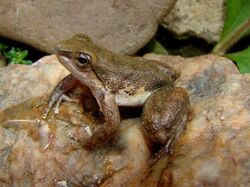Biology:Rheobates palmatus
| Rheobates palmatus | |
|---|---|

| |
| Scientific classification | |
| Domain: | Eukaryota |
| Kingdom: | Animalia |
| Phylum: | Chordata |
| Class: | Amphibia |
| Order: | Anura |
| Family: | Aromobatidae |
| Genus: | Rheobates |
| Species: | R. palmatus
|
| Binomial name | |
| Rheobates palmatus (Werner, 1899)
| |
| Synonyms[2] | |
|
Phyllobates (Hypodictyon) palmatus Werner, 1899 | |
Rheobates palmatus is a species of frog in the family Aromobatidae.[2][3] It is the type species of genus Rheobates erected in 2006.[4] Its common name is palm rocket frog. It is endemic to Colombia.[2] It is considered to be part of a species complex.[1][3]
Description
Rheobates palmatus has cryptic, brown or gray dorsal colouration and posteriorly granular skin texture. Toe webbing is extensive.[4] It is also distinguishable by its large size. Its tadpoles are also large and are a uniform colour without markings.[5]
Distribution and habitat
Rheobates palmatus is endemic to the Colombian Andes and is found on both sides of the Cordillera Oriental and on the eastern side of the Cordillera Central range at heights of 350 to 2,200 metres (1,150 to 7,220 ft) above sea level.[6] As it has not been found higher than 2,500 metres (8,200 ft), it is effectively divided into three distinct populations as those on the two slopes of the Cordillera Oriental are separated by a continuous, high altitude ridge. It has been found that the vocalisations of the males when seeking a mate varies between the different populations.[6] It is a terrestrial species and is found in rainforests and cloud forests. In the Rio Magdalena Valley it is also found in pasture land, crops and even polluted streams.[1]
Status
Rheobates palmatus does not like being disturbed by humans. Near the Villavicencio–Bogotá road it became locally extinct but returned to its previous breeding sites when a new road was built, removing the traffic away from the old highway.[5] The IUCN Red List of Threatened Species lists this species as being of "Least Concern" on the grounds that it has a reasonably wide range and a stable population, and seems to be an adaptable species.[1]
References
- ↑ 1.0 1.1 1.2 1.3 IUCN SSC Amphibian Specialist Group (2019). "Rheobates palmatus". IUCN Red List of Threatened Species 2019: e.T55124A85893845. doi:10.2305/IUCN.UK.2019-3.RLTS.T55124A85893845.en. https://www.iucnredlist.org/species/55124/85893845. Retrieved 12 November 2021.
- ↑ 2.0 2.1 2.2 Frost, Darrel R. (2019). "Rheobates palmatus (Werner, 1899)". Amphibian Species of the World: an Online Reference. Version 6.0. American Museum of Natural History. http://research.amnh.org/vz/herpetology/amphibia/Amphibia/Anura/Aromobatidae/Anomaloglossinae/Rheobates/Rheobates-palmatus.
- ↑ 3.0 3.1 Acosta Galvis, A. R. (2019). "Rheobates palmatus (Werner, 1899)". Lista de los Anfibios de Colombia: Referencia en linea V.09.2019. https://www.batrachia.com/orden-anura/aromobatidae-16-spp/rheobates-palmatus/.
- ↑ 4.0 4.1 Grant, T.; Frost, D. R.; Caldwell, J. P.; Gagliardo, R.; Haddad, C. F. B.; Kok, P. J. R.; Means, D. B.; Noonan, B. P. et al. (2006). "Phylogenetic systematics of dart-poison frogs and their relatives (Amphibia: Athesphatanura: Dendrobatidae)". Bulletin of the American Museum of Natural History 299: 1–262. doi:10.1206/0003-0090(2006)299[1:PSODFA2.0.CO;2].
- ↑ 5.0 5.1 Lynch, John D. (2006). "The amphibian fauna in the Villavicencio region of eastern Colombia". Caldasia 28 (1): 135–155. ISSN 0366-5232. http://www.scielo.org.co/scielo.php?pid=S0366-52322006000100014&script=sci_arttext.
- ↑ 6.0 6.1 Bernal, Ximena E.; Guarnizo, Carlos; Lüddecke, Horst (2005). "Geographic variation in advertisement call and genetic structure of Colostethus palmatus (Anura, Dendrobatidae) from the Colombian Andes". Herpetologica 61 (4): 395–408. doi:10.1655/04-87.1.
Wikidata ☰ Q28056503 entry
 |


